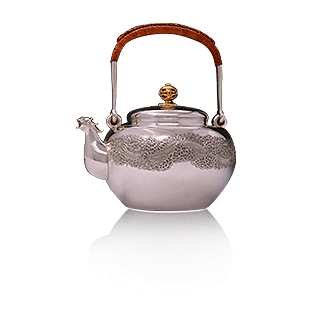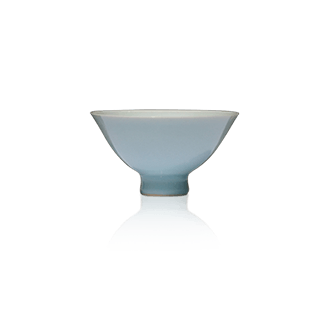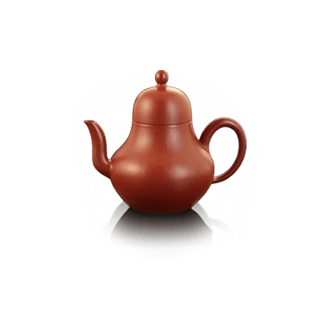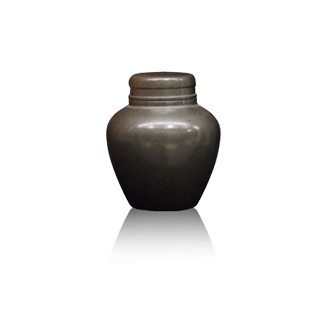





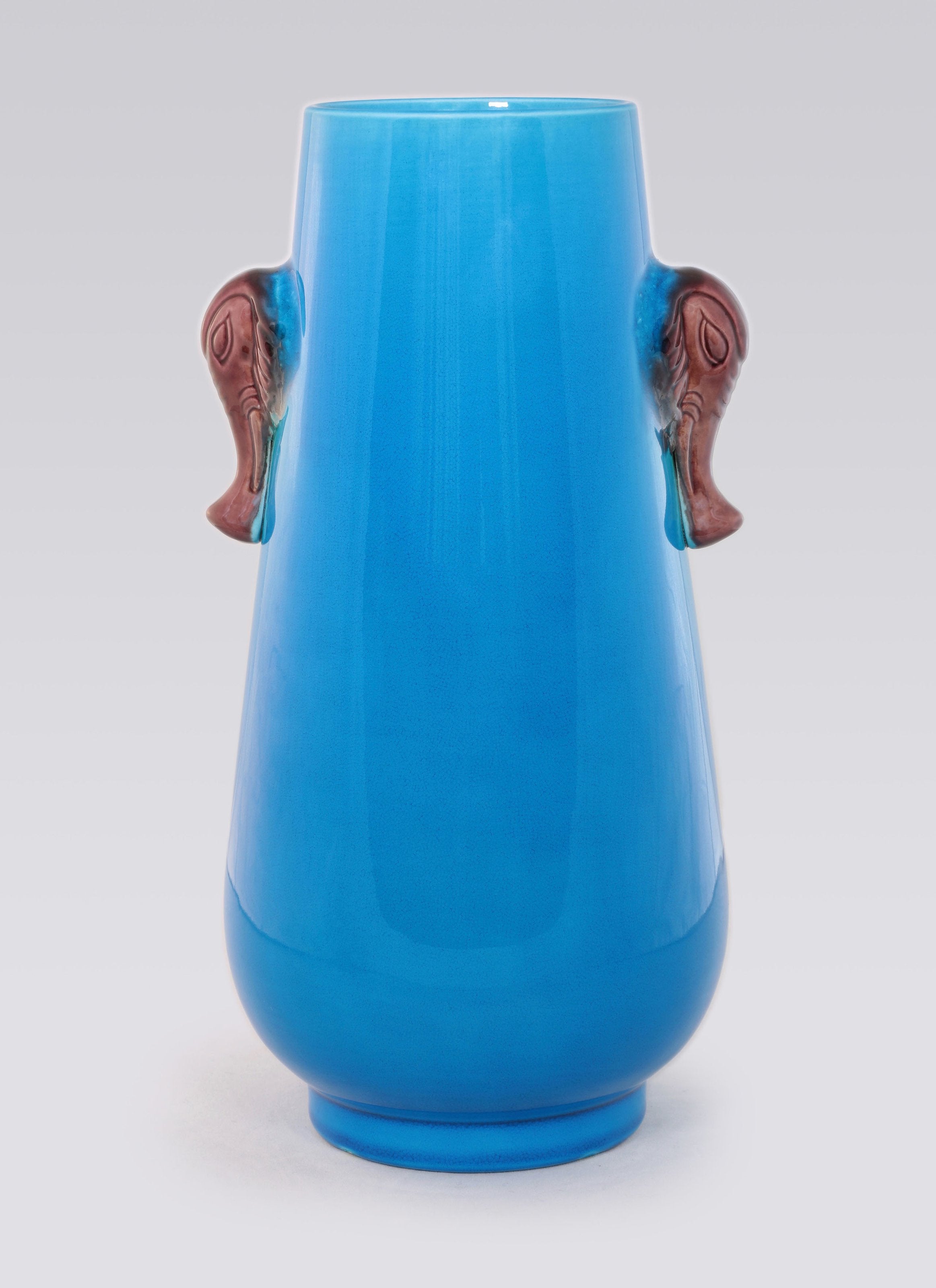


Falconite (peacock blue) elephant trunk bottle











Falconite (peacock blue) elephant trunk bottle
Falconite (peacock blue) elephant trunk bottle
Tu Jinghua, an inheritor of the intangible cultural heritage of the art of making emerald glaze, personally prepared the recipe.
Peacock blue glaze is a beautiful colored glaze, named after peacock feathers. Glazes with a greenish tint are called peacock green, and those with a bluish tint are called peacock blue. It is also known as "peacock blue," "peacock green," "jade glaze," "French glaze," "French blue," and "auspicious glaze," among other names. Peacock blue glaze uses copper as a colorant and is a low-temperature glaze that produces a bright blue hue after firing. It boasts a gorgeous glaze, a rich variety of types, and further development led to the creation of decorative patterns, greatly enriching the variety of Chinese ceramics.
Pure and vast, the Silk Road shines brightly
"Peacock blue glaze" is a traditional glaze color from West Asia. Its products were brought to the Central Plains during trade exchanges in the Tang and Song dynasties and were successively produced in folk kilns during the Jin and Yuan dynasties. Judging from the craftsmanship of Jin and Yuan products, the turquoise blue ware of the Cizhou kiln system in the 13th century was of relatively high quality, and many exquisitely painted "turquoise blue with black flowers" pieces still exist today.
China began producing peacock blue glazed wares during the Song Dynasty. By the Tang Dynasty, Chinese peacock blue glaze had already been influenced by West Asia.
Porcelain production developed rapidly during the Xuande period of the Ming Dynasty. Peacock blue official kiln porcelain from the Ming Dynasty was extremely valuable at the time, and those that have been preserved intact today are extremely rare.
The Qing Dynasty blossomed with unparalleled beauty
The Qing Dynasty was the golden age of Chinese porcelain making, especially the early and middle periods, which represented the peak of Chinese ceramic history. The production of peacock blue glaze plummeted in the late Ming Dynasty, becoming extremely rare. However, during the Kangxi era, peacock blue glaze ware began to flourish again, gradually reaching another peak in its history.
The peacock blue glaze of the Kangxi period exhibited more variation in color than that of the Xuande and Chenghua periods of the Ming dynasty, ranging from deep, vibrant green to pale and pure. During the Yongzheng and Qianlong periods, the shapes and forms of peacock green glazed porcelain became even more diverse than those of the Kangxi era. From the mid-Qing dynasty onward, the porcelain industry gradually declined.
Quiet and noble, a darling of the collecting world
Among glaze colors, "peacock blue" is widely recognized as beautiful by most collectors of ancient ceramics; it is the color of a clear sky after rain.
Tu Jinghua, an inheritor of the intangible cultural heritage of glaze preparation, explained that due to the traditional "pouring glaze" technique, the natural fluidity of the glaze creates a texture that is thinner at the top and thicker at the bottom on the porcelain body. The colored glazes Tu Jinghua uses are all hand-prepared. Because the techniques for handmade products cannot be exactly the same, each firing produces a different effect, making each piece unique.
The first important characteristic of peacock green glaze is its bright and vibrant blue color, extremely rare in ancient Chinese ceramic glazes. The second important characteristic is its clear glaze layer, with very few bubbles, crystals, and unmelted glaze material. The third important characteristic is the dense, fine crackle pattern on the glaze surface, resembling fish roe, which is very distinctive. Throughout its history, Tu Jinghua's peacock green glaze pieces have been highly sought after by collectors. His works are exquisitely crafted, with beautiful glaze colors and an overall bright and vibrant blue luster, possessing a classical elegance. Because the production process of peacock green glaze is quite complex, it requires a shaped bisque or a pre-painted blank, which is fired at a high temperature. Then, the peacock green glaze is applied to the fired porcelain, followed by a medium-temperature firing. Due to the extreme difficulty of firing and the limited production volume, it is extremely precious.
Ancient porcelain-making techniques are like shining pearls in the history of civilization. Due to various reasons, they have sunk into the long river of history. We need to rediscover the simple raw materials used by our ancestors, study their original techniques, wipe away the dust, and restore the brilliance of these pearls to appreciate the wisdom of our forefathers. Tu Jinghua is one of these inheritors of these techniques, and he is practicing them personally. The formulation of glazes is very mysterious to people. Because most people lack hands-on experience or related theoretical knowledge, even those who have been collecting and researching ancient ceramics for a long time may still feel unfamiliar with this field. We cannot always limit ourselves to understanding the surface crackles, colors, and glaze shrinkage points of the objects; the most important thing is to rediscover the lost traditional techniques and make the Fa Cui glaze porcelain no longer seem so mysterious.
Born in 1969 into a ceramic family in Jingdezhen, Tu Jinghua is a representative inheritor of the Jingdezhen intangible cultural heritage—the preparation of Fa Cui glaze. He is also the only inheritor in Jingdezhen who has mastered the preparation, coloring, and firing techniques of medium-temperature Fa Cui glaze.
He began learning the craft from his father in 1987; in January 1989, he joined the Jingdezhen Sculpture Porcelain Factory; in 1996, the company underwent restructuring, and he independently established a ceramic studio specializing in medium-temperature jade glaze decoration materials, which he still runs today.
Apprenticeship: Grandfather Tu Yixin, a late ceramic glaze blending master in Jingdezhen during the Republic of China era (later joined the Ceramic Research Institute of the Ministry of Light Industry);
Apprenticeship: Tu Jincai, father, a veteran craftsman at the Jingdezhen Sculpture Porcelain Factory;
Features:
1) It is made by hand-pouring glaze and adding colors directly onto the unglazed porcelain body and then firing it;
2) The glaze and body are tightly bonded, and the glaze contains fine crackles resembling fish roe.
3) The glaze is bright, thick, warm, elegant and clean, with a strong glassy texture, giving people a pleasing feeling.
Mid-temperature glaze decoration is mainly used for traditional porcelain. In recent years, while working on decorating traditional porcelain with mid-temperature glaze, Tu Jinghua has also been committed to promoting the combination of glaze and modern art porcelain, so that more people can understand glaze.
In 2014, the artwork "Chang'e Flying to the Moon" by Liu Yuanchang, a master of Chinese arts and crafts, was decorated. In the same year, it was also decorated with "The Dawn Ceremony" by Chen Peihuo, an inheritor of provincial intangible cultural heritage. The decorative effect of the colored glazes in the artworks received high praise and recognition from experts.
They also participated in the recording of the large-scale documentary "Craftsmanship in Pottery" about the 72 porcelain-making processes in Jingdezhen, which enabled more people to recognize and understand the medium-temperature jade glaze.
Tu Jinghua, an inheritor of the intangible cultural heritage of the art of making emerald glaze, personally prepared the recipe.
Peacock blue glaze is a beautiful colored glaze, named after peacock feathers. Glazes with a greenish tint are called peacock green, and those with a bluish tint are called peacock blue. It is also known as "peacock blue," "peacock green," "jade glaze," "French glaze," "French blue," and "auspicious glaze," among other names. Peacock blue glaze uses copper as a colorant and is a low-temperature glaze that produces a bright blue hue after firing. It boasts a gorgeous glaze, a rich variety of types, and further development led to the creation of decorative patterns, greatly enriching the variety of Chinese ceramics.
Pure and vast, the Silk Road shines brightly
"Peacock blue glaze" is a traditional glaze color from West Asia. Its products were brought to the Central Plains during trade exchanges in the Tang and Song dynasties and were successively produced in folk kilns during the Jin and Yuan dynasties. Judging from the craftsmanship of Jin and Yuan products, the turquoise blue ware of the Cizhou kiln system in the 13th century was of relatively high quality, and many exquisitely painted "turquoise blue with black flowers" pieces still exist today.
China began producing peacock blue glazed wares during the Song Dynasty. By the Tang Dynasty, Chinese peacock blue glaze had already been influenced by West Asia.
Porcelain production developed rapidly during the Xuande period of the Ming Dynasty. Peacock blue official kiln porcelain from the Ming Dynasty was extremely valuable at the time, and those that have been preserved intact today are extremely rare.
The Qing Dynasty blossomed with unparalleled beauty
The Qing Dynasty was the golden age of Chinese porcelain making, especially the early and middle periods, which represented the peak of Chinese ceramic history. The production of peacock blue glaze plummeted in the late Ming Dynasty, becoming extremely rare. However, during the Kangxi era, peacock blue glaze ware began to flourish again, gradually reaching another peak in its history.
The peacock blue glaze of the Kangxi period exhibited more variation in color than that of the Xuande and Chenghua periods of the Ming dynasty, ranging from deep, vibrant green to pale and pure. During the Yongzheng and Qianlong periods, the shapes and forms of peacock green glazed porcelain became even more diverse than those of the Kangxi era. From the mid-Qing dynasty onward, the porcelain industry gradually declined.
Quiet and noble, a darling of the collecting world
Among glaze colors, "peacock blue" is widely recognized as beautiful by most collectors of ancient ceramics; it is the color of a clear sky after rain.
Tu Jinghua, an inheritor of the intangible cultural heritage of glaze preparation, explained that due to the traditional "pouring glaze" technique, the natural fluidity of the glaze creates a texture that is thinner at the top and thicker at the bottom on the porcelain body. The colored glazes Tu Jinghua uses are all hand-prepared. Because the techniques for handmade products cannot be exactly the same, each firing produces a different effect, making each piece unique.
The first important characteristic of peacock green glaze is its bright and vibrant blue color, extremely rare in ancient Chinese ceramic glazes. The second important characteristic is its clear glaze layer, with very few bubbles, crystals, and unmelted glaze material. The third important characteristic is the dense, fine crackle pattern on the glaze surface, resembling fish roe, which is very distinctive. Throughout its history, Tu Jinghua's peacock green glaze pieces have been highly sought after by collectors. His works are exquisitely crafted, with beautiful glaze colors and an overall bright and vibrant blue luster, possessing a classical elegance. Because the production process of peacock green glaze is quite complex, it requires a shaped bisque or a pre-painted blank, which is fired at a high temperature. Then, the peacock green glaze is applied to the fired porcelain, followed by a medium-temperature firing. Due to the extreme difficulty of firing and the limited production volume, it is extremely precious.
Ancient porcelain-making techniques are like shining pearls in the history of civilization. Due to various reasons, they have sunk into the long river of history. We need to rediscover the simple raw materials used by our ancestors, study their original techniques, wipe away the dust, and restore the brilliance of these pearls to appreciate the wisdom of our forefathers. Tu Jinghua is one of these inheritors of these techniques, and he is practicing them personally. The formulation of glazes is very mysterious to people. Because most people lack hands-on experience or related theoretical knowledge, even those who have been collecting and researching ancient ceramics for a long time may still feel unfamiliar with this field. We cannot always limit ourselves to understanding the surface crackles, colors, and glaze shrinkage points of the objects; the most important thing is to rediscover the lost traditional techniques and make the Fa Cui glaze porcelain no longer seem so mysterious.
Born in 1969 into a ceramic family in Jingdezhen, Tu Jinghua is a representative inheritor of the Jingdezhen intangible cultural heritage—the preparation of Fa Cui glaze. He is also the only inheritor in Jingdezhen who has mastered the preparation, coloring, and firing techniques of medium-temperature Fa Cui glaze.
He began learning the craft from his father in 1987; in January 1989, he joined the Jingdezhen Sculpture Porcelain Factory; in 1996, the company underwent restructuring, and he independently established a ceramic studio specializing in medium-temperature jade glaze decoration materials, which he still runs today.
Apprenticeship: Grandfather Tu Yixin, a late ceramic glaze blending master in Jingdezhen during the Republic of China era (later joined the Ceramic Research Institute of the Ministry of Light Industry);
Apprenticeship: Tu Jincai, father, a veteran craftsman at the Jingdezhen Sculpture Porcelain Factory;
Features:
1) It is made by hand-pouring glaze and adding colors directly onto the unglazed porcelain body and then firing it;
2) The glaze and body are tightly bonded, and the glaze contains fine crackles resembling fish roe.
3) The glaze is bright, thick, warm, elegant and clean, with a strong glassy texture, giving people a pleasing feeling.
Mid-temperature glaze decoration is mainly used for traditional porcelain. In recent years, while working on decorating traditional porcelain with mid-temperature glaze, Tu Jinghua has also been committed to promoting the combination of glaze and modern art porcelain, so that more people can understand glaze.
In 2014, the artwork "Chang'e Flying to the Moon" by Liu Yuanchang, a master of Chinese arts and crafts, was decorated. In the same year, it was also decorated with "The Dawn Ceremony" by Chen Peihuo, an inheritor of provincial intangible cultural heritage. The decorative effect of the colored glazes in the artworks received high praise and recognition from experts.
They also participated in the recording of the large-scale documentary "Craftsmanship in Pottery" about the 72 porcelain-making processes in Jingdezhen, which enabled more people to recognize and understand the medium-temperature jade glaze.









Frequently asked questions
Use the FAQ section to answer your customers' most frequent questions.
Order
Yes, we ship all over the world. Shipping costs will apply, and will be added at checkout. We run discounts and promotions all year, so stay tuned for exclusive deals.
It depends on where you are. Orders processed here will take 5-7 business days to arrive. Overseas deliveries can take anywhere from 7-16 days. Delivery details will be provided in your confirmation email.
You can contact us through our contact page! We will be happy to assist you.





